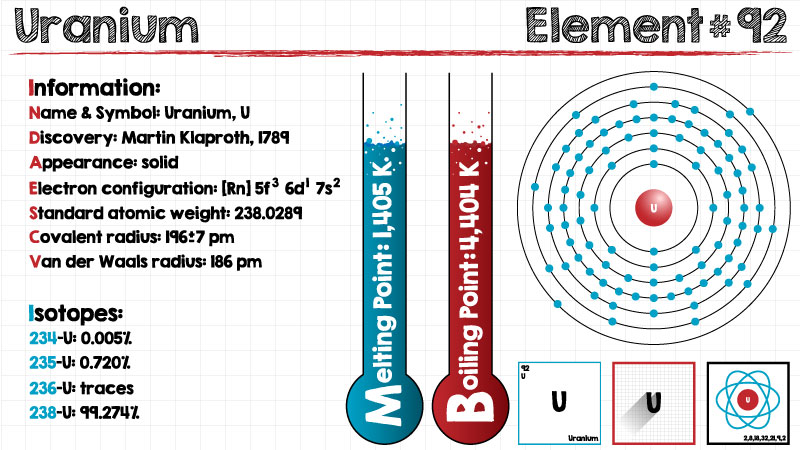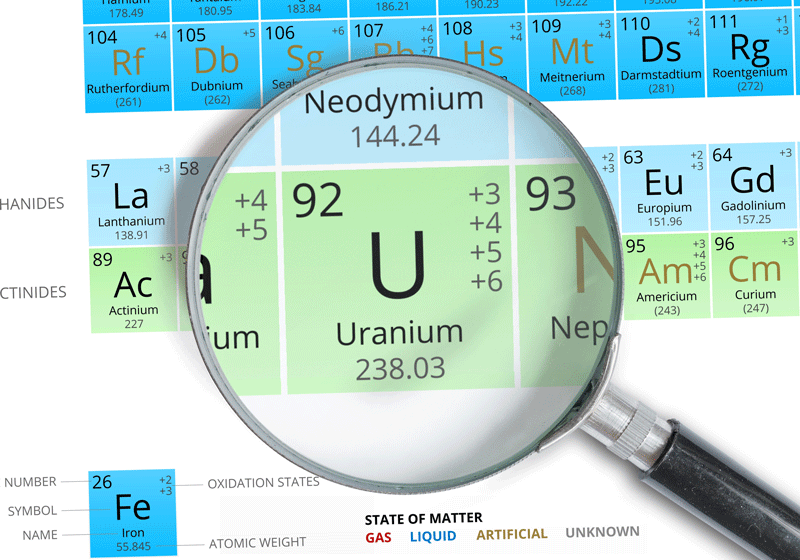Elemental Uranium is a silver-colored radioactive metal. Small amounts of uranium are found naturally in soil. rock formations, and water. Natural uranium is composed of three forms (isotopes): Uranium-234, Uranium-235, and Uranium-238.
Over 99 percent of the uranium found in nature is uranium-238. Uranium is unstable, and breaks down into other elements including radium and radon. This process is called decay, and alpha radiation is released during the process of decay. Both radium and radon are also unstable, and decay to other components, releasing even more radioactive energy. The total amount of radioactivity emitted is combined and often referred to as gross alpha. The gross alpha results are quantified using the term picoCuries per liter (pCi/l).
Uranium-238 decays very slowly and is not the same form of uranium used in nuclear weapons or nuclear power plants. Depending on the type of analysis, uranium results are measured in terms of micrograms per liter (µg/l ), or picoCuries per liter (pCi/l).
What about Radium?
Radium (chemical symbol Ra) is a naturally occurring radioactive metal. Radium is a radionuclide formed by the decay of uranium and thorium in the environment. The most common isotopes. For example, uranium has thirty-seven different isotopes, including uranium-235 and uranium-238. of radium are Ra-226 and Ra-228.
How Does Uranium Get Into Drinking Water?
Uranium typically enters into water when groundwater dissolves minerals that contain uranium. The amount of uranium in water (mostly found in groundwater, but sometimes also surface waters) will vary depending upon contact time with the rock as well as how much uranium was in the rock. There can be is a large degree of variation within relatively small areas, so you should always test and never assume Uranium levels in water. High levels of uranium indicate the potential for radon and radium also to be present.
How Can Uranium Affect My Health?
Naturally occurring uranium has very low levels of radioactivity. However, the chemical properties of uranium in drinking water are of greater concern than its radioactivity. Most ingested uranium is eliminated from the body, but a small amount is absorbed and carried through the bloodstream. Studies show that drinking water with elevated levels of uranium can affect your kidneys over time. Bathing and showering with water that contains uranium is typically not a significant health concern.
Do I Have Uranium in My Drinking Water?
To find out if you have uranium in your drinking water you must test for it. I recommend a local certified lab, or a reputable online lab like National Testing Labs.
What Do The Results of My Water Test Mean?
The current US federal standard, known as the maximum contaminant level (or MCL), for uranium in public water supplies is 30 µg/l (which is roughly equivalent to 30 pico Curies per liter). The current federal standard (MCL) for adjusted gross alpha (includes radiation from radium but excludes radiation from radon and uranium) in public water supplies is 15 pCi/l. The current federal MCL for combined radium 226 and radium 228 in public water supplies is 5 pCi/l.
Private well owners are not required to follow this standard, but if your water test shows uranium contamination greater than 30 µg/l, you should seriously consider treating your water. Since results can vary from season to season, it is prudent to re-test whenever the results are above 10 µg/l. While treatment is highly recommended only at confirmed levels of 30 µg/l or higher, some people may choose to increase their safety margin and treat water that contains lower levels.
If you follow the screening protocol described above you will also have results for gross alpha and radium to evaluate. For the purposes of comparison it is best to compare these results to current standards for public water supplies.
What Type of Treatment Will Reduce Uranium Contamination in My Water?
Two common methods to remove Uranium and it’s isotopes from water are reverse osmosis and ion exchange. A simple softening system can significantly reduce Radium and following that with Reverse Osmosis will bring it down to virtually undetectable levels. Uranium is removed by Anion Exchange and Reverse Osmosis. Anion resin in the chloride form can lower uranium levels by >90%. A mixed bed of cation and anion resins is useful for some applications that are used to remove both radium and uranium. Type 1 or Type 2 anion strong base anion (SBA) resins can be used for treating Uranium on its own. Type 2 resins are typically preferred since they’re less-likely to form undesirable odors in the process.
After obtaining a detailed water quality analysis, consult with your local Certified Water Specialist to learn more about what will work best for your home or business.

